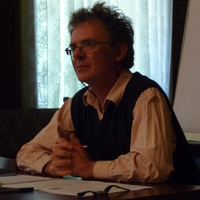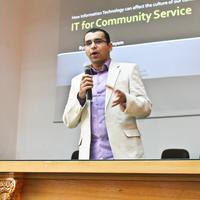
Karol Śledzik
Related Authors
Paul D. Guild
University of Waterloo
Galen Strawson
The University of Texas at Austin
Steven Pinker
Harvard University
Mohammed Seyam
Mansoura University
Don Ross
University College Cork
Abd Rahman Ahlan
International Islamic University Malaysia
Bob Jessop
Lancaster University
Alejandra B Osorio
Wellesley College
Steffen Boehm
University of Exeter
Colin Williams
The University of Sheffield
InterestsView All (37)










Uploads
Papers by Karol Śledzik
treatments and diagnostics to clinics and hospitals more quickly and effectively, which leads to better healthcare for patients. Technology transfer can also aid in the development of new drugs and therapies that can be effective in the treatment of civilization diseases. The paper aims to evaluate the technology transfer process in the field of civilization diseases, using COVID-19 as an example of a pandemic that requires quick development and transfer of technology. To achieve the assumed
goal, we propose a multivariate synthetic ratio in the field of civilization diseases (SMTT—Synthetic Measure of Technology Transfer) to analyze data from the Global Data database. We used submeasures like SMTT_value (Synthetic Measure of Technology Transfer_value) and SMTT_quantity (Synthetic Measure of Technology Transfer_quantity) to measure technology transfer and put the data into a graph. Our analysis focuses on 14 diseases over a period of 10 years (2012–2021) and
includes nine forms of technology transfer, allowing us to create a tool for analysing the process in multiple dimensions. Our results show that COVID-19 is similar in terms of technology transfer to diseases such as diabetes, cardiovascular diseases, neurodegenerative diseases, and breast cancer, even though data for COVID-19 is available for only 2 years.
This publication is the result of an analysis of 139 audit protocols resulting from the Agency's implementation of audits (of which 27 protocols related to AFs examining PIEs and 108 to other AFs).
As part of these audits, nearly 279 dossiers of services performed by AFs were analysed (of which 80 dossiers related to PIEs and the remaining 199 related to entities other than PIEs). These 279 dossiers included 39 consolidated audit dossiers.
The method of analysis contained in the publication was based on the requirements formulated in Article 112(1) of the ASA and on the "Policies and Procedures for the Management of the Audit System and the Conduct of PANA Audits". (Polish Audit Oversight Agency, 2022). During the audit period, the AF used the standard KSB/ISA 540 for estimates in the audit engagements. The standard KSB/ISA 540(Z) was only used in the audits that will be audited by PANA in the next period.
This analysis is an extension of the publication "Summary of audits initiated by PANA by the end of June 2021 in relation to fair value estimates. Selected issues" (Polish Audit Oversight Agency, 2021).
In view of the purpose of the publication, reference is made to the most common anomalies identified in relation to the audit of estimates, leaving aside the fact that it is correct in principle to give an opinion on the financial statements.
treatments and diagnostics to clinics and hospitals more quickly and effectively, which leads to better healthcare for patients. Technology transfer can also aid in the development of new drugs and therapies that can be effective in the treatment of civilization diseases. The paper aims to evaluate the technology transfer process in the field of civilization diseases, using COVID-19 as an example of a pandemic that requires quick development and transfer of technology. To achieve the assumed
goal, we propose a multivariate synthetic ratio in the field of civilization diseases (SMTT—Synthetic Measure of Technology Transfer) to analyze data from the Global Data database. We used submeasures like SMTT_value (Synthetic Measure of Technology Transfer_value) and SMTT_quantity (Synthetic Measure of Technology Transfer_quantity) to measure technology transfer and put the data into a graph. Our analysis focuses on 14 diseases over a period of 10 years (2012–2021) and
includes nine forms of technology transfer, allowing us to create a tool for analysing the process in multiple dimensions. Our results show that COVID-19 is similar in terms of technology transfer to diseases such as diabetes, cardiovascular diseases, neurodegenerative diseases, and breast cancer, even though data for COVID-19 is available for only 2 years.
This publication is the result of an analysis of 139 audit protocols resulting from the Agency's implementation of audits (of which 27 protocols related to AFs examining PIEs and 108 to other AFs).
As part of these audits, nearly 279 dossiers of services performed by AFs were analysed (of which 80 dossiers related to PIEs and the remaining 199 related to entities other than PIEs). These 279 dossiers included 39 consolidated audit dossiers.
The method of analysis contained in the publication was based on the requirements formulated in Article 112(1) of the ASA and on the "Policies and Procedures for the Management of the Audit System and the Conduct of PANA Audits". (Polish Audit Oversight Agency, 2022). During the audit period, the AF used the standard KSB/ISA 540 for estimates in the audit engagements. The standard KSB/ISA 540(Z) was only used in the audits that will be audited by PANA in the next period.
This analysis is an extension of the publication "Summary of audits initiated by PANA by the end of June 2021 in relation to fair value estimates. Selected issues" (Polish Audit Oversight Agency, 2021).
In view of the purpose of the publication, reference is made to the most common anomalies identified in relation to the audit of estimates, leaving aside the fact that it is correct in principle to give an opinion on the financial statements.